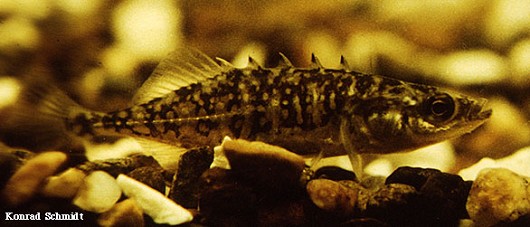Brook stickleback
-
Scientific NameCulaea inconstans
-
NativeNo
-
Identification
 Brook stickleback. Photo by Konrad Schmidt, Nongame Fish Biologist, Division of Ecological Services, Minnesota Department of Natural Resources.
Brook stickleback. Photo by Konrad Schmidt, Nongame Fish Biologist, Division of Ecological Services, Minnesota Department of Natural Resources.- Laterally compressed body
- 5 short spines precede and are completely separate from the 9-11 rays of the dorsal fin
- Anal fin with 1 spine and 9-11 rays
- Pelvic fins are a single spine and a single stout ray
- Pectoral fins have 9-11 rays
- Round to truncated tail
- 30-36 tiny bony plates run along either side on the lateral line
- Olive-green back and sides, with a lighter belly and varying degrees of mottling
- Breeding males are dark green to black and occasionally have red on the fins
- Short caudal peduncle
- Small oblique mouth
-
Life History
Brook sticklebacks prefer cool, clear waters with extensive aquatic plant beds. This finds them in a variety of habitats including spring ponds, slow moving streams, river edges, irrigation ditches, and clear lakes. They tend to stick close to shallow, weedy areas where they can hide in the plant beds or bury themselves in the substrate of organic matter when a threat is present. In these vegetation beds they hunt for small invertebrates, especially the larvae of midges and other insects, picking them off plants or catching them in the water column.
Brook sticklebacks breed between April and June of their second summer when temperatures reach 15-19°C. A male constructs a nest by collecting various pieces of debris from the bottom and attaching them to the base of an aquatic plant. He will then attract a female to the nest through a form of courtship dance. The female will lay 100-200 eggs in small batches that hatch 7-11 days later. During this time the male will maximize the embryos' oxygen intake by waving water over them with his fin. He will also guard the newly hatched larvae until they are active enough to escape the nest. Most brook sticklebacks only live to be 2 years old and average 61 mm TL. Individuals over 65 mm TL are rare and 87 mm TL is the recorded maximum.
-
Links to Other ResearchN / A
